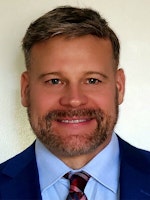When people ask me about my portable dental practice, these are their most common questions:
- “Do you have buses?”
- “Are you a nonprofit?”
- “Where do you get the grant funding from?”
After answering “no,” “no,” and “none,” I typically get a bewildered look, followed by, “How are you profitable?”
Commonwealth Mobile Oral Health Services (CMOHS) is a for-profit portable dental practice that receives no grant funding. Portable dental care is different from mobile dental care. With portable dental care, dental teams travel with dental equipment and supplies in their personal vehicle to a location, unload their dental equipment, and set it up in a room to treat patients. When services are complete, the dental equipment is broken down, packed up, and placed back in their personal vehicles for transport to another location. Some examples of locations we have visited over the years are schools, nursing homes, prisons, state facilities, employers, and people’s homes.
You may also be interested in ... Mobile dental clinics in the 21st century: Not your father's old RV
With mobile dental care, vans, buses, or trailered units are brought to a location where patients enter the unit for dental services. Regardless of whether it is mobile or portable dental care, the dental practitioners involved offer convenience to patients through the dental services they provide.
CMOHS was started in 1979 by my late father, Dr. Mark J. Doherty, at the request of the Massachusetts Department of Public Health, Office of Oral Health. It was initially created to provide comprehensive dental services to youth at the Department of Youth Services in the Boston area, as these patients did not have access to dental providers. CMOHS then expanded to treat children in the Boston public schools who did not have a dental home.
Fast-forward 40 years, and now we have several dental teams (which include a dentist, assistant, and hygienist) that travel to more than 300 schools and locations throughout Massachusetts, providing comprehensive dental services to underserved and underinsured populations.
When providing portable dental care, it’s important to know who the payers are and what that reimbursement will look like. CMOHS is a community-based dental practice with about 95% of our patient population participating with MassHealth (Medicaid). In addition, most patients we treat are under age 21. Compared to other states’ Medicaid programs, Massachusetts reimburses very well for children’s dental services.
Undoubtedly, 40 years is a long time for any business to be in existence, especially in the post-COVID economy. In this ever-changing dental environment, our attention needs to be directed toward the business side of dentistry as we face current workforce shortages, increased salaries, and inflation levels at an all-time high. These challenging times often force us to create new solutions to our current problems—in essence, they allow us to evolve.
You may also be interested in ... Mobile dentistry: The road less traveled
There are many resources available that provide information on how a portable/mobile dental practice can be successful, but I’ll share my thoughts just to keep it real. As I reflect on what has kept CMOHS successful, these strategies come to mind:
Know your state rules and regulations.
- Streamline processes.
- Minimize overhead.
- Maximize the services you provide.
- Implement technologies.
- Consider your team, accommodation, and reputation.
Know your state rules and regulations
You must know the rules in your state before you set out to provide portable/mobile dental services. Being noncompliant with rules and regulations is a good way to end a great opportunity quickly and put a target on your back! Know what permissions/licensure you need to have, which services can be provided by dental staff (dentists, hygienists, assistants), and what emergency items you need to have on-site.
Streamline processes
Having an electronic dental record (EDR) that fits your needs and works the way that you need it to work—and a staff properly trained on using it—maximizes everyone’s potential. With a portable dental practice, you must be mindful of the many moving parts and how to make the workflow efficient. Workflow considerations include scheduling, dissemination of medical/consent forms to partners/patients, retrieval of those forms, report-sharing with partners, rapport with local dental offices for referrals for more extensive care, and communication with the “champion” of the location you are providing care for.
The revenue cycle management (RCM) process should also be flawless. Clearly defining staff members’ roles and responsibilities within the RCM process allows for a high collection rate and little for adjustments. When billing Medicaid, that RCM cycle should be fewer than 30 days, and I recommend having a staff member dedicated to tracking down overdue receivables.
Minimize overhead
Why spend more money on something if you don’t have to? Portable dental equipment is much less expensive to purchase and maintain than a mobile dental bus or van. It’s also nimbler and more discreet than large vans, causing less disruption at the location you’re servicing. With mobile dental vans/buses, there is usually a large up-front fee (or large monthly payment) in addition to fees for hiring a driver with a license to drive the vehicle, insurance, and expenses for electrical and upkeep. What happens if the mobile van isn’t working one day, or your driver is out sick? How much production would you lose? Rolling into a location in a big flashy mobile van is impressive, but does it justify the thousands of dollars in expenses?
Be savvy and hone your negotiating skills with vendors when purchasing equipment and materials. If you are providing services to underserved populations or if you are a large portable/mobile dental program, ask about getting community health center- or DSO-reduced fees from those vendors. I like to preach, “Standardization leads to predictability, and predictability leads to success.” When all our dental health-care professionals are using the same or similar materials and equipment, we know what those expenses will look like monthly.
Maximize the services you provide
As an endodontist and a perfectionist, I strive for quality of care. I expect a similar quality of care from our general dental health-care professionals, too, and I make that well known. In fact, we have outside entities perform quality assurance audits annually on all providers. From a quality perspective, this allows us to acknowledge and reward providers when a job is well done, and it also gives us insight to address individuals if deficiencies are noted.
We expect our providers to maximize their time and provision of services when on location. For example, if an initial exam is performed and disease is noted, and the patient is willing and able, the dental provider should be addressing restorative needs as well as diagnostic and preventive needs in that visit.
Another important way to maximize services is to allow your staff to work to the top of their licensure. Does your state allow dental hygienists and assistants to perform services such as fluoride/SDF applications and placement of sealants? These can be potentially significant revenue streams, so know your state’s rules and regulations.
Implement technologies
Many of us are turning to artificial intelligence (AI) and various new technologies, especially to help combat the workforce shortage and replace missing personnel. Although it can take time, researching and implementing the technology that fits your practice is a must and will eventually lead to cost savings. Invest in an IT firm that can give guidance and help make your platforms interoperable. Investing in proper systems flow alleviates headaches and allows the dental team to perform at a high level. It can take time to implement the setup that is right for you and your practice, but eventually you should see positive effects on your bottom line.
Consider your team, accommodation, and reputation
Even with all the impressive innovations in dental technology, it’s still all about the people. Creating a team of people who are passionate, have buy-in to the practice mission, and share a similar vision is key to establishing a strong foundation. Having solid relationships with partners, accommodating their requests, building trust, and performing quality dentistry all lead to a successful portable/mobile dental practice.
Editor's note: This article appeared in the January 2024 print edition of Dental Economics magazine. Dentists in North America are eligible for a complimentary print subscription. Sign up here.
Mark Doherty, DMD, is cofounder and CEO of D4 Practice Solutions, owner and CEO of Commonwealth Mobile Oral Health Services, and a partner of Southcoast Endodontics. He is an associate clinical instructor for the postgraduate endodontic residents at the Boston University Henry M. Goldman School of Dental Medicine (BUGSDM). A sixth-generation dentist, Dr. Doherty is a graduate of the University of Pennsylvania School of Dental Medicine. He completed his postdoctoral training at BUGSDM in endodontics and root canal therapy.







